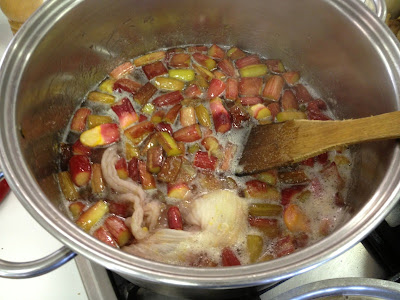Cramming
 |
| O-dark-thirty on Exam Day |
When was the last time I studied for a test? Driver’s
License and Food Handler’s do not count.
At the six week, half-way point here we are all tested on
what we have learned. But it’s not multiple choice or wax-eloquently essay
questions. No, this would be a …. “practical test” (ominous music swelling in
the background).
For
the first test, we were give a list of some 25 possible kitchen skills, two of
which everyone would do, and two would be from the master list which
included: fileting a round fish, mayonnaise, short crust pastry, yeast rolls,
scones, various incarnations of eggs, knife skills on a myriad of vegetative
victims… you get the idea.
The
second test would be going in to one of the large kitchens and identifying any
of a number of herbs and lettuces. Now, herbs I know. But honestly… some of the
lettuces here do not show up in our local Safeway: Cos, Lollo Rosso, Mizuma,
Mizuna, sorrels, mustards, rocket, land cress, and the like (and unlike).
For
two weeks I would walk through the acre “glass house” (aka green house to us),
taking pictures, picking leaves, tasting leaves, drawing pictures. It seemed like
resistant information. At lunchtime, we students would pick at our salads, holding up specimens to see who could identify the particular green
culprit.
 |
| Identifying two-day old, wilted leaves, removed from their Mother-plant |
For
every Wednesday I’ve been here, I’ve shown up at 7:45 am for a walking class
through the grounds on organic gardening. The week of the exam, I decided to
give myself the gift of the extra hour of sleep. Wouldn’t you know … that
Wednesday (two days before the exam), they went to the herb garden and glass house to give a bonus talk on
the herbs and lettuces that the test would include.
The
Friday of the exam I was up before dawn cramming any last-minute stuff that
might make a difference: making a batch of “Mummy’s Sweet Scones,” sacrificing an entire dozen eggs for French omelets, slicing/dicing shrooms, cukes, and onions.
 |
| Mummy's Sweet Scones practice ... |
 |
| Ronco has nothing on me! |
That morning at school, the agony would be
prolonged as we first sat through a three-hour lecture/demonstration on pizzas.
I have to admit, it was a good stress reliever. Nevertheless, I surreptitiously
flipped through my iPhoto files on lettuce leaves.
 |
| Darina just keeps turning our pizza variations for three hours -- that woman is absolutely the Energizer Bunny! |
After
lunch, all the students changed into their uniforms and waited for their
assigned times to enter each of the two testing kitchens. One more time I
walked down to the glass house. The fresh air and walking was a good tonic for
the mounting angst.
 |
| I almost expect them to sport Disney-esque faces and start singing to me a clever ditty designed to help me memorize all of their names! |
My
turn came for Kitchen No. 1. I was
assigned a station where there were 10 glass jars of herbs, and 10 glass jars
of lettuce leaves… all numbered. I had to write down a name for each one of
those. And for the herbs, we also had to give two specific recipes, which use
that particular herb. My eyes blurred as I hyper-focused. I also seemed to be
on hyper-drive. When I finished the identification, I went to another spot
where there was a description of a multi-coursed meal – and an assortment of
“cutlery,” dishes and glasses. I had to “set the table” for that meal. Next I was
to properly offer, serve and pour a wine selection.
 |
| The Waiting Room where we make each other more nervous. |
Kitchen
No. 2 would be where we would all slice and sweat an onion, and make a
parchment piping bag – and be given two tasks at random. We would have 20
minutes… and everything from remembering to sharpen our knives (not over the
cutting board and wiping the blades before you used them), to what side of the
cutting board you used for what task , to time management would be observed by
a proctoring instructor. Personally I was hoping for mayonnaise and segmenting
an orange, and dreading filleting a round fish (I’d already botched a cod and
was looking up numbers in the phone book through the resulting fillet) – or
choux pastry.
 |
| "The Secret Cart" that has product plates with our names attached. |
As
I walked in the kitchen I was given my station and an instructor who had never
worked with me. She didn’t smile one bit. She brought me my plates: an onion, a
triangle of parchment paper, some 10 mushrooms, 2 eggs, whole butter and
clarified butter. I didn’t know whether to be relieved or insulted! My two
random tasks were to sauté mushrooms and fry two eggs.
I
sharpened my knives, wiped them, mentally made my order of work. I knew what
she (my proctor) would be looking for: sweat onions to ‘soft’ without color,
use the butter wrapper for a second layer of insulation… put plenty of color in
the sautéed mushrooms. For the eggs she would want to see me basting them and
not getting them too done.
It
happened. And then it was over. My wonderful husband met me outside with a
picnic we would share as we sped off for the three-day weekend to the Dingle
Peninsula.
The entire weekend, I didn’t order one salad.
 |
| Three beautiful days unwinding on the Dingle Peninsula. |



















